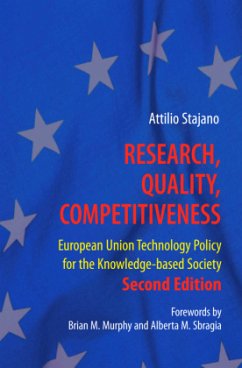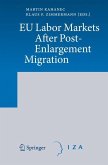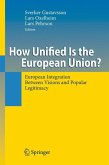This book covers a gap in EU policy literature by addressing the intersection between research policy and industrial policy. It analyzes how the EU supports the competitiveness of domestic companies and the common objective of sustained (and sustainable) economic growth. An exhaustive introduction to the founding principles, institutions, and activities of the EU and an overview of the 15 new and candidate member states are also provided. This new edition is thoroughly revised and extended to incorporate updated and new material and data on the new R&D Framework Program, the Lisbon Agenda, the EU Reform Treaty, and the EU enlargement. The appendix and accompanying website contain ancillary distance-learning material, extended readings, country-specific data, and other materials for producing course notes and visuals. The book will be useful for lecturers, students, politicians and civil servants who are interested in EU technology policy as well as for professionals who are involved in EU funded R&D projects.
The European Union (EU) was launched as a response to the economic dominance of the United States and - to a lesser degree - the Soviet Union. The nations of Western Europe were too small to compete against large scale and diversi?ed economies on their own. Six countries, eventually expanding to 27 (and counting), took a series of steps toward progressively deeper integration: the removal of int- nal tariffs, the construction of a common external tariff, the elimination of many (but not all) non-tariff barriers leading to a single market, and the adoption of a c- mon currency by 15 of the member states. The EU today equals and even exceeds the U. S. on many key indicators of performance. In the process, two similar but nonetheless divergent models of social and economic life stand in contrast with each other. The U. S. is more committed to capitalism and does little to dilute its harsh edges while the nations of Europe support wider social safety nets and more active regulation of commercial activity to mute the crueller aspects of the free-market. Until recently, the economic dynamism of the U. S. called into question whether the so-called European social model was sustainable in an era of globalization. The EU was slipping in competitiveness and was being challenged by new global pow- houses like China and India. Although the U. S. economy has slowed, there is little indication that European countries are capable of leveraging the situation to their advantage.
The European Union (EU) was launched as a response to the economic dominance of the United States and - to a lesser degree - the Soviet Union. The nations of Western Europe were too small to compete against large scale and diversi?ed economies on their own. Six countries, eventually expanding to 27 (and counting), took a series of steps toward progressively deeper integration: the removal of int- nal tariffs, the construction of a common external tariff, the elimination of many (but not all) non-tariff barriers leading to a single market, and the adoption of a c- mon currency by 15 of the member states. The EU today equals and even exceeds the U. S. on many key indicators of performance. In the process, two similar but nonetheless divergent models of social and economic life stand in contrast with each other. The U. S. is more committed to capitalism and does little to dilute its harsh edges while the nations of Europe support wider social safety nets and more active regulation of commercial activity to mute the crueller aspects of the free-market. Until recently, the economic dynamism of the U. S. called into question whether the so-called European social model was sustainable in an era of globalization. The EU was slipping in competitiveness and was being challenged by new global pow- houses like China and India. Although the U. S. economy has slowed, there is little indication that European countries are capable of leveraging the situation to their advantage.
From the reviews:
"As a consultant, I have learned that not only organizations have to be transformed, but also the way people look at them.This is true in business, but also in politics. The new edition of this book gives a sharper vision on a major European effort. It will not change the reality of Europe, but will boost your perception of what's going on." - Luc de Brabandere, Vice-President, The Boston Consulting Group
"Allocation for schools and education are believed [by most] to be a cost. Stajano proves with cogent analysis that education and knowledge are instead veritable infrastructures for social cohesion and economic productivity. Allocations for school and education are also necessary investments for life and productivity of a nation." - Tullio De Mauro, former Minister of Education, Italy; Professor of Linguistics, University of Rome
"For Europe the magic word is competitiveness. In order to be successful we should invest more in quality, research, education and innovation. This book is an excellent guide about European and global integration and competitiveness. It analyses not only where we stand, but also where should we go and what we should do. It is highly recommendable reading for those who care about the future of Europe." - Tibor Palankai, Emeritus Professor of Corvinus University of Budapest
"Attilio Stajano significantly contributed to shaping the developments of the European research program 'Esprit' and its follow-up program 'Information Society Technologies'. This book reflects his enthusiasm for European collaborative research which he rightly highlights as a success story. It provides a valuable and detailed source of information on IT research funded by the European Union in recent years with the goal of contributing to European competitiveness." - Dr. Rosalie Zobel, Director, European Commission, Brussels
"As a consultant, I have learned that not only organizations have to be transformed, but also the way people look at them.This is true in business, but also in politics. The new edition of this book gives a sharper vision on a major European effort. It will not change the reality of Europe, but will boost your perception of what's going on." - Luc de Brabandere, Vice-President, The Boston Consulting Group
"Allocation for schools and education are believed [by most] to be a cost. Stajano proves with cogent analysis that education and knowledge are instead veritable infrastructures for social cohesion and economic productivity. Allocations for school and education are also necessary investments for life and productivity of a nation." - Tullio De Mauro, former Minister of Education, Italy; Professor of Linguistics, University of Rome
"For Europe the magic word is competitiveness. In order to be successful we should invest more in quality, research, education and innovation. This book is an excellent guide about European and global integration and competitiveness. It analyses not only where we stand, but also where should we go and what we should do. It is highly recommendable reading for those who care about the future of Europe." - Tibor Palankai, Emeritus Professor of Corvinus University of Budapest
"Attilio Stajano significantly contributed to shaping the developments of the European research program 'Esprit' and its follow-up program 'Information Society Technologies'. This book reflects his enthusiasm for European collaborative research which he rightly highlights as a success story. It provides a valuable and detailed source of information on IT research funded by the European Union in recent years with the goal of contributing to European competitiveness." - Dr. Rosalie Zobel, Director, European Commission, Brussels








